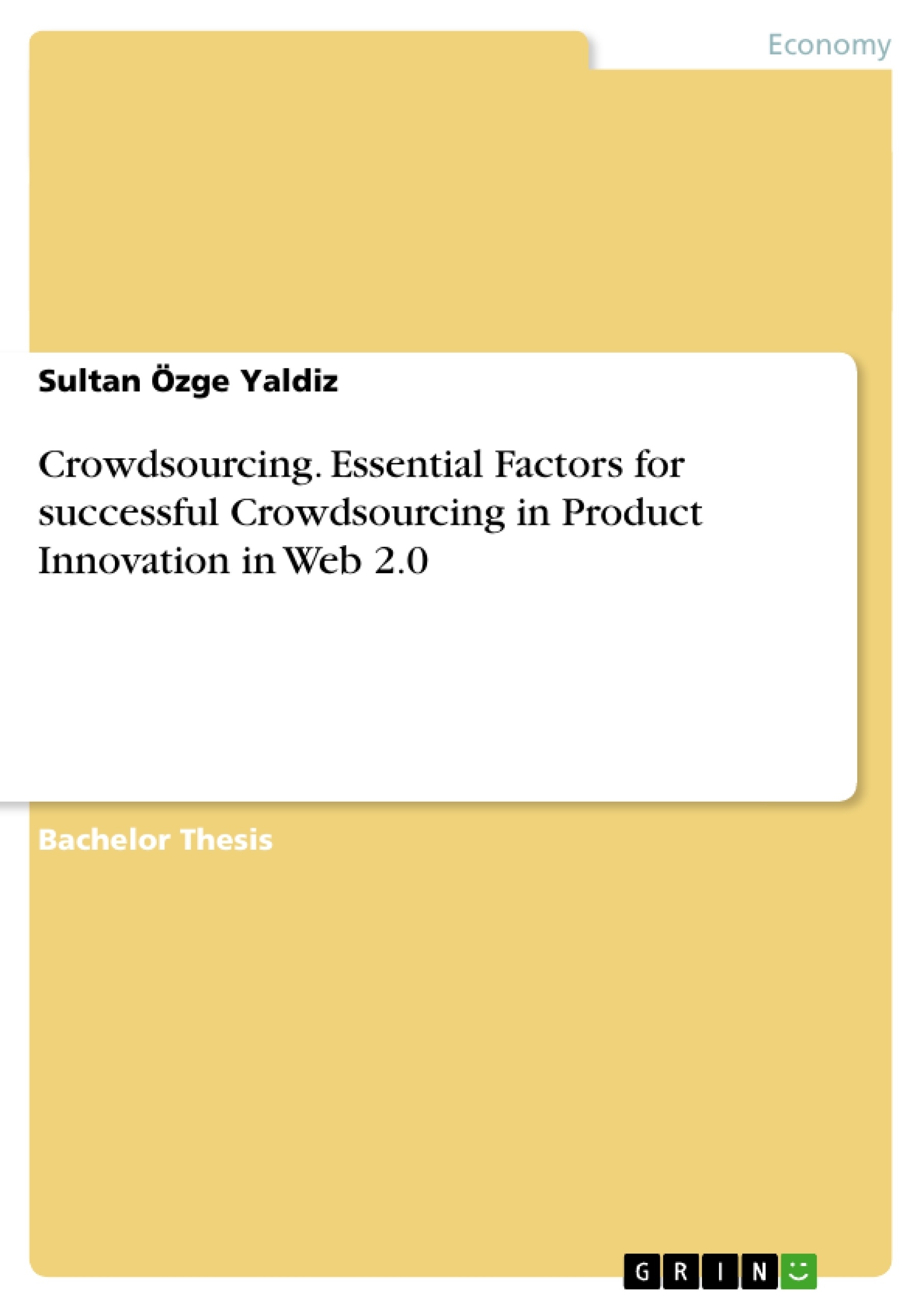At large, innovation is a key factor for the success and persistence of organizations in today's business. In order to develop successful innovation, information of two kinds is needed; information based on customers' and the market's needs, as well as information on how to transform the gained knowledge into corresponding products (Diener and Piller, 2011). The paradigm of Crowdsourcing can be applied to obtain both kinds of essential information enabled through direct interaction with customers and takers, providing an enhanced inflow of intelligence.
The work at hand deals with Crowdsourcing and particularly crowd-based product innovation. Crowdsourcing is a relatively new conceptualized paradigm, which is why the literature does not offer countless research papers on the topic and the market is not overloaded with companies applying the concept, although the theory is very promising. Nonetheless, not all companies who have ventured the step towards Crowdsourcing have experienced positive outcomes: on the contrary, some encountered rants from the crowd, as well as image losses (Papsdorf and Voß, 2009).
The first purpose of this work is to illustrate how broad the term Crowdsourcing is and what opportunities it offers for businesses by providing an overview of the common forms. a further purpose is to depict where, in what form and how those activities take place. The cornerstones for a successful outcome are already set at the beginning of a project, whereby this paper describes single decisions to make along a Crowdsourcing process and their influence on the project's course, in order to understand how and why each decision during the process can be determining. thus marking a third purpose. The focus of this third purpose is on Crowd Innovation leading to the primarily purpose, namely to identify and name essential factors for the success of a crowd product innovation project in Web 2.0. These factors will demonstrate which steps and rules have to be followed by a company to implement prosperous Crowdsourcing activities in this field.
Inhaltsverzeichnis (Table of Contents)
- INTRODUCTION
- Introduction to the Problem
- Purpose
- Methodological Construction
- PRINCIPLES OF CROWDSOURCING
- What is Crowdsourcing?
- Definition
- Benefits of Crowdsourcing
- Correlation with Open Innovation, Open Source and Outsourcing
- The requirement of Web 2.0
- Types of Crowdsourcing
- Crowd Innovation
- Crowd Contest & Challenge
- Crowd Collaborative Communities
- Crowd Complementors
- Crowd Creativity
- Crowd Funding
- Crowd Collective Knowledge
- Microworking
- Crowd Voting
- Hosting Platforms of Crowdsourcing
- Intermediate Platforms
- R & D Platforms
- Marketing & Design
- Freelance Platform
- Idea - Platform
- In-House platforms
- Free solution-seeking communities
- Idea trading platforms
- The Crowdsourcing – Process
- Phase 1: Preparation
- Phase 2: Initiation
- Phase 3: Execution
- Phase 4: Analysis
- Phase 5: Application
- Product Innovation in the context
- Factor of success
- CROWDSOURCED PRODUCT INNOVATION IN PRACTICE
- Tchibo-ideas.de - Participate. Have a say. Shape
- Basic Information
- Clustered Breakdown
- McDonald's \"My Burger - from you, for you\"
- Basic Information
- Clustered Breakdown
- The Netflix Prize
- Basic Information
- Clustered Breakdown
- Sun Night Solar via InnoCentive
- Basic Information
- Clustered Breakdown
- Determination of Essential Factors for Success
- Concept related decisions & Objective
- Motivators & Drivers
- Interaction with the Crowd
- Communication with Crowd
- Transparency of the activity
- "Do's" & "Don'ts” in Crowdsourcing product innovation
Zielsetzung und Themenschwerpunkte (Objectives and Key Themes)
The objective of this bachelor thesis is to examine the essential factors for successful crowdsourcing in product innovation within the context of Web 2.0. The study aims to analyze the practical applications and underlying principles of crowdsourcing by focusing on real-world examples and case studies. Key themes explored include:- Defining and understanding crowdsourcing within the Web 2.0 environment
- Identifying and analyzing various types and applications of crowdsourcing, including crowd innovation, crowd creativity, and crowd funding
- Exploring the critical role of hosting platforms and their influence on crowdsourcing initiatives
- Dissecting the stages of the crowdsourcing process, emphasizing the key factors that contribute to successful outcomes
- Analyzing the implementation of crowdsourcing in product innovation by examining specific case studies, such as Tchibo-ideas.de, McDonald's "My Burger - from you, for you," the Netflix Prize, and Sun Night Solar via InnoCentive
Zusammenfassung der Kapitel (Chapter Summaries)
The introduction provides a brief overview of the research problem, outlining the purpose and methodological approach of the thesis. It sets the stage for exploring the emerging field of crowdsourcing and its application to product innovation in Web 2.0.
Chapter 2 delves into the principles of crowdsourcing, defining the concept and exploring its benefits, connections to open innovation, open source, and outsourcing, and the importance of Web 2.0. It further analyzes different types of crowdsourcing, including crowd innovation, crowd creativity, and crowd funding, and examines the role of hosting platforms such as intermediate platforms, in-house platforms, free solution-seeking communities, and idea trading platforms. The chapter concludes by outlining the key phases of the crowdsourcing process, emphasizing the importance of preparation, initiation, execution, analysis, and application.
Chapter 3 examines real-world applications of crowdsourced product innovation through detailed case studies. It analyzes the Tchibo-ideas.de platform, McDonald's "My Burger - from you, for you" campaign, the Netflix Prize competition, and Sun Night Solar's utilization of InnoCentive. These case studies illustrate how different companies and organizations leverage crowdsourcing to achieve product innovation.
Schlüsselwörter (Keywords)
Crowdsourcing, Web 2.0, Product Innovation, Open Innovation, Open Source, Outsourcing, Crowd Innovation, Crowd Creativity, Crowd Funding, Hosting Platforms, Crowdsourcing Process, Case Studies, Tchibo-ideas.de, McDonald's, Netflix Prize, InnoCentive.- Quote paper
- Sultan Özge Yaldiz (Author), 2014, Crowdsourcing. Essential Factors for successful Crowdsourcing in Product Innovation in Web 2.0, Munich, GRIN Verlag, https://www.grin.com/document/282322




